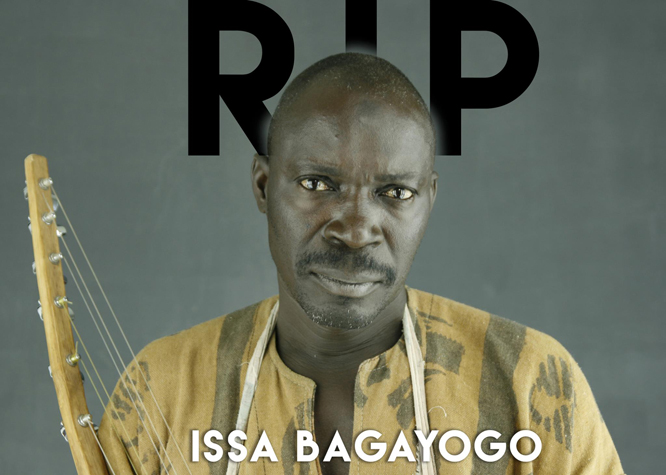TOP TEN NEW RELEASES & TOP SIX REISSUES OF 2016
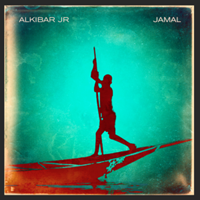
|
Alkibar Junior sounds comforting to me as a member of the drinking classes, and their music has the familiar strains of Niafunké which is the funky roots music of Timbuktu, Mali. There's that lovely dissonant horsehair fiddle on here in counterpoint to the crisp acoustic guitar, which is played by Diadié Bocoum, younger brother of Afel Bocoum. Singer Sekou Touré was a member of Ali Farka Touré's entourage. When the jihadis invaded their land in 2012 many people fled but the band members remained at home, practicing secretly in their bedrooms while outwardly looking like collaborators: growing their beards and tending their rice paddies. Like other recent traditional Malian music, post-Ali Farka, there are strong elements of rock and blues, especially when trap drums kick in. Jamal is a collection of praise songs for the various individuals who kept the community together during the past few years of hardship. To reinforce their ranks the band brought in the other members of Ali Farka Touré's band for support and a strong guest list, including Afel Bocoum (who produced), Mamadou Kelly, Hamma Sankaré, and Yoro Cissé; Leila Gobi and Ami Wassidje come in on backing vocals (names that will be familiar from the best albums issued recently by Akwaaba, Clermont, and so on), plus the great Zoumana Tereta who has played sokou (horsehair fiddle) on Bassekou Kouyaté's albums, also appears. I don't think it is hype to say this is destined to become a Malian classic.
|
 | DENGUE FEVER
THE DEEPEST LAKE (Tuk Tuk Records)
I have to confess that when I was in college my education took a strange turn: instead of going to lectures I sat in a state of euphoria induced by my new room-mates' taste for Arabic plant extracts and the suddenly vast collection of records we shared (My collection consisted of Frank Zappa's Uncle Meat, Coltrane's Live at Birdland and Tommy by the Who). I listened to a lot of Country Joe & the Fish while staring at the plaster moulding on the ceiling. (While the US had the British invasion, we in Britain had the reciprocal psychedelic invasion.) The overall mood of this new Dengue Fever disc takes me back to those heady mis-spent days of my late teens. Now I get a lot of world fusion music pitched at me: Ethiopian jazz meets rock, New Orleans meets World Beat, African meets White Guys Who Like Fela, etc. It's endless and usually tiresome. But when you come to some real professionals, like Dengue Fever, they have the white rock thing down (San Francisco psychedelia, and British Invasion) but also a great feeling for the exotic quotient that comes from the Cambodian flavor they infuse into their albums and performances. It's not just coming from Chhom Nimol their lead vocalist with her unearthly birdlike melodies, the guitar is also steeped in lush instrumentation and the percussion fits the mood from straight-up rock to African to spacey (cuica). The mood is dreamy and cinematic and you just want to lay back and go on a little mental journey. The band has been touring the world performing their music for a decade and this is the first time in almost four years they have been back into the studio to record new material. They confidently stretch out and jam on all ten new compositions, as if they had been playing them for years. Their Cambodian-rootsiness is pretty deeply engrained now with all its flowery psychedelia but their LA punk roots are still evident in the grunging guitar and the pulsing bedrock of African roots percussion. Check out the wonderful video of their first single off the album "Tokay." There's power and passion in this new disc but also a raw edge. They formed their own label and have reissued most of their back-catalog with bonus material as their sound has started to be picked up by commercials and films and become better known.
|
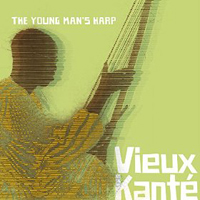
|
VIEUX KANTE
THE YOUNG MAN'S HARP (Stern's STCD1127)
Ali Farka Touré named his son, Vieux, or "Old man," which seems a strange name for a lad and one assumes that he will grow into it. Vieux Kanté, however, never got to be a respected elder, dying unexpectedly aged 31 in 2005. He had spent a decade mastering the kamalé ngoni and when he became proficient on it, he decided to expand it by adding more strings. After adding two he added a few more until he had 12 strings on his instrument making it more like a kora. He also worked on his technique, bending notes like a blues guitarist, popping the strings like Larry Graham and damping the strings to create bell-like tones. He could even make them squeak like a cuica! He was well-known in the club scene in Bamako with a regular hotel gig that usually ran into the wee hours, but never got to taste the rewards of international recognition that so many of his countrymen achieve when they are discovered and their music promoted outside Mali. Now posthumous recognition should be his with a fine set of original traditional music performed with a small group comprising electric bass, a djembe drummer and a vocalist, Kabadjan Diakité from the Orch National de Guinée and Super Diata Band of Zani Diabaté, who sings on three tracks. Kanté was born blind and spent a lot of his childhood sitting home with the radio on. He discovered his brothers had a kamalé ngoni (or young man's harp) in their room and soon took to recreating what he heard on the radio on this instrument. I did not know (prior to reading Banning Eyre's liner notes) that this instrument was invented in the 1960s as a smaller version of the hunter's harp, the donson ngoni. As Eyre says, "No Wassoulou music album offers such a variety of rhythms and textures as we hear here." And it is to Eyre's persistence and Stern's action that we can now appreciate this brief gem by a master of Malian music, one who created an instrument to match the music in his head.
|
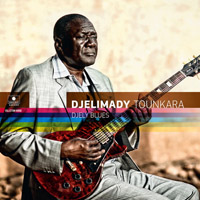 |
DJELIMADY TOUNKARA
DJELY BLUES (Label bleu)
Djelimady is now the elder statesman of Malian music. He has effectively taken up the mantle of Ali Farka Touré and has released a brilliant new solo album, with much less fanfare than surrounded the Donkeyman's later efforts. In the last century Djelimady was the leader of the Super Rail Band, one the legendary Malian bands which launched many stars to international prominence. But of course it was the singers Mory Kanté and Salif Keita everyone noticed, rather than the phenomenal guitarist, who himself was the son of griot praise singers. The Rail Band was founded by saxophonist Tidiani Koné in 1970, but the modest guitarist soon assumed authority. His style was a mix of George Benson and Chuck Berry as the band switched from traditional Mandingue melodies to more Western-oriented rock tunes. Students of guitar will also note elements of Bill Frissell and even the smooth Hank B. Marvin in his playing. But he also picked up a triplet run from his childhood study of the n'goni and adapted it to guitar. In 2001 he released his first solo album Sigui, which won the BBC World Music Award the next year. Solon Kôno followed in 2005. Now after a decade he has brought forth another solid instrumental set with his Les Paul guitar to the fore, but he has not left the acoustic sound behind. He is backed by acoustic guitar and light percussion: Sayon Camara plays rhythm and Yacouba Sissoko is on calabash. There's also Samba Kanté on electric bass. The "Blues" of the title is evident in his diminished chord runs. But there's also the Afro-Cuban element, which came from his youth but then was revived with his involvement with Eliades Ochoa and the Afrocubism project in 2010. And he told me he was inspired by flamenco as a young man: you can tell from the trills and flourishes that augment his playing. Here there's a remake of "Mansa," which was the title track of the Super Rail Band album recorded in 1995. Two or three saxes, two trumpets and three vocalists swelled that opus, not to mention Jean-Philippe Rykiel who snuck in on "claviers" like a drop of bleach in the colored wash. Now it's stripped to essentials. Here Djelimady performs "Sansenesougouro" from the new album.
|

|
This is the 34th album by this Brasilian icon: the septuagenarian "Queen of Samba." I have lived in Brasil and never heard of her, but then what do I know? Gay black women were never allowed a voice before this century. Her style of music is called "Samba sujo" or dirty samba, and she has the gravelly vocals to deliver on that promise. Her backing band on this are Paulistas who bring rock, free jazz and noise to the party. They wrote the tunes for her, and the theme of the album is "carnaval as the apocalypse," which definitely accords with my experience of carnaval over three successive seasons. I remember flying into São Paulo and as the plane lowered into the city approach I could see the polluted rivers glowing ominously like radioactivity and small fires burning in waste ground sending out acrid black smoke, it really looked like a scene out of Hieronymus Bosch. Now, with that backdrop, imagine a 70-year-old woman who has had an inordinately tough life singing like a weary punker with a bunch of out-of-control guitars and electronica over chugging drums and punch drunk horns. Maisumdiscos (literally "one more record") have a thing about reinvigorating the careers of elderly ladies, which is great when they can sing, like Elza and the amazing Dona Onete, I just wish they would put a bit more effort into the packaging: the sterile black on white lettering is wretched and doesn't suggest anything like the passionate content. Here, I doodled this alternate cover in 15 minutes while listening to the album (You're welcome, Mais Um).
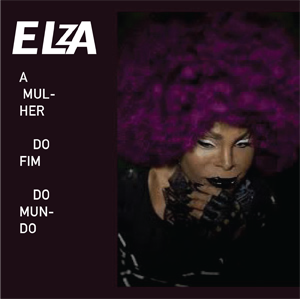
|
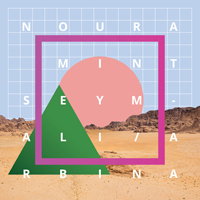
|
NOURA MINT SEYMALI
ARBINA (Glitterbeat GBCD038)
Traditional Mauretanian music in a not so traditional arrangement for the second international release by this powerhouse quartet. The producer Matthew Tinari is also the trap drummer and along with the stop-tempo bass they bring a rock sensibility to the set. And in the rare moments when her husband's electric guitar is not prominent, Seymali's voice and her ardine playing are clearly rooted in the folk traditions of the Moors. I wonder if her unaccompanied set would be as engaging to Western audiences, but I think the album's success is actually in the Western reframing. "Mohammedoun" contains a familiar riff: it's "Had to cry today" by Blind Faith (listen to the progression at 43 seconds) and throughout this album I hear echoes of other rock songs of my youth, so I assume the guitarist has a similar musical background to mine -- or else I am hallucinating -- even though he is Mauretanian and his wife is a griot, singing traditional songs. The opening cut, "Arbina," invokes the Lord above while "Mohammedoun" is about His man on the spot, known as the Prophet. At first I thought it was "Presence of the Lord," but Winwood reassured me of the right title. There's another tune or nursery rhyme from my childhood bubbling up in here, in "Richa," but so far back I am having a hard time retrieving it. My sense of Jeiche Chighaly's playing is he is more into Fairport Convention and Traffic than Cream though he likes to rip out the blues riffs. "Ghlana" eases into one of the desert blues we know so well from Tinariwen and the host of others who love the jam: there's two guitars on here, maybe double-tracked since only Chighaly is credited. On "Ghizlane," Noura's voice stands out, soaring above the band in a traditional song about seeing giraffes at the oasis and imagining running after them, then realizing how earthbound we are with our awkward bodies compared to the fleet-footed giant quadruped: "I follow the footsteps to an impossible end."
|
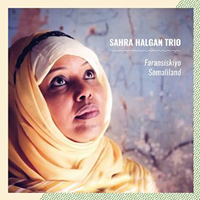 | SAHRA HALGAN TRIO
FARANSISKIYO SOMALILAND (Buda Musique)
Somaliland is a breakaway part of Somalia in what used to be British Somaliland until 1960, then it was under a dictator from '69 until civil war broke out in 1991. Whenever there's a news story it usually involves some horror or atrocity. This affects their neighbors most when the al-Shaabab "where's my kebab" rebels from Somalia cross into Kenya, which has a huge permeable border, and indiscriminately murder innocent people. Sahra Halgan worked as a nurse while engaging in the fight for liberty as a singer, but was eventually forced into exile in Europe. Meanwhile the rest of the world cannot tell Somaliland from Somalia so nothing changes. Nevertheless she played an important part as a young woman with her televised songs about the liberation struggle inspiring the young soldiers. She spent 20 years in Lyon in Southern France and met her band: Aymeric Krol and Mael Salètes who support her on guitar and drums, plus there are guests on four tracks. Her repertoire includes a few originals and many traditional songs taught to her by her mother or an old troubadour named Abdinasir Macalin, who accompanies himself on oud. The trio produced this album then returned to Hargeisa, the capital of Somaliland, to make a documentary film about her journey which is include in the package. The duo pack a punch behind her vocals, also singing harmony. The songs feature the trance-inducing repetition and intensity familiar from other desert warriors such as Bombino or Lobe Traoré. Krol plays kamalengoni on the title track, and there's a fair amount of acoustic guitar backing, however I would have liked to have heard the oud of Macalin included on here. Maybe it would not have got made without the two French musicians, or had the same exposure, but it was good to see that after 25 years she is still remembered by her first name wherever she went in her native land.
|
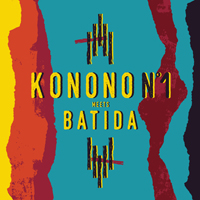
|
After the disastrous Mbongwana Star album I approached this new release from Konono Numero Un with trepidation, after all it has that subtitle "Meets Batida," and who is this Batida whose name means to beat, rap, knock or slam? -- A deejay and producer on the Lisbon scene, so I feared another clash of cultures and a clutter of drum programs and samples over some pure likembe riffs. But I am relieved and happy to report the result is a delight. Batida is the stage name of an Angolan, Pedro Coquenão, who adds tasteful touches of electronica and brings in a couple of his Lisboan pals to toast and sing, but is fully connected to the Angolan-Congolese bridge evident in the Bazombo music they share. Angola borders the Namibian deserts and swamps to the South, Congo to the East and Brazil to the West. The borders of course were erected in Colonial times regardless of the peoples who might be divided by them. The Bakongo lived on both sides but during the Angolan war of independence and subsequent civil war many fled to Congo and then after peace many fled back when the Congo started falling apart. Then of course there's a tradition of migrant workers so we have famous Congolese musicians like Sam Mangwana and Ricardo Lemvo who are of Angolan extraction. But Konono have upset conventional notions of what Congolese music sounds like: critics can't decide whether to compare them to German bands like Can, Einstürzende Neubauten or Kraftwerk, to acid house or to Lee Perry. Whatever it is they have, they have it aplenty, even if critics may call it "sophisticated brutality." They have also recorded with Björk ("Earth Intruders"), Juana Molina and Herbie Hancock. Vincent Kenis the guiding force behind the essential Congotronics series is a Belgian musician who heard them on the famous double cassette put out by OCORA in 1986, Musiques urbains à Kinshasa (It was too long for an LP so appeared on two cassettes; even when OCORA put it on CD they had to edit it, unfortunately). When he arrived in Kinshasa in 1989, Kenis was invited to play keyboards in Koffi Olomide's Quartier Latin, which was the most in-demand band of the day. He has also performed on Papa Wemba and even Franco & OK Jazz albums. Kenis spent his spare time trying to track down the electrified folk music, or musique tradi-moderne that he loved. It took him two years but he found them, and then presented Staff Benda Bilili, Kasai All Stars and the Karindula Sessions to our music collections, much to our collective delight. After a European tour, Batida invited the band to his garage-turned-studio in Lisbon. He started playing dikanza, a big Angolan guiro, and after half an hour of repetition keeled over on the floor, as the band cracked up. After a few rehearsals they did a couple of live shows then returned to the garage studio to record this loose and lively session. It is not over-produced, but captures the direct trancelike mood of great likembe music.
|
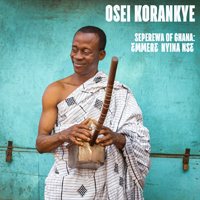 | OSEI KORANKYE
SEPEREWA OF GHANA (Akwaaba Music)
Akwaaba is a label dedicated to bringing new African music, particularly Ghanaian music, to the rest of the world, and does it digitally (to keep overhead down). Label founder Benjamin LeBrave finds that there is even a market in Africa for other African music and is trying to network from his base in Ghana, where he works as a DJ as well as producer. His latest release is a traditional one, and really strikes a chord, literally and figuratively. The seperewa is a harp played by the Ashanti and Akan people, a traditional Ghanaian instrument that looks and sounds, to some extent, like a stripped-down kora. Though it is centuries old it almost vanished when the guitar came along and spread inland from the coast in the early 20th century. But the seperewa repertoire was transferred to the guitar so didn't die out. The number of strings is variable; Osei, who learned from his grandfather, went up to eight and then ten strings in his own instrument which further distinguishes it from the sound of a guitar. The songs were indigenous to Ghana throughout the nineteenth century and are quite different from Malian kora tunes. You can sample it on the Akwaaba website, and that will make you want to own this wonderful collection.
|
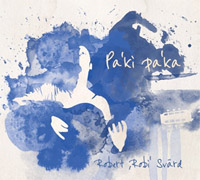 | ROBERT "ROBI" SVARD
PA'KI PA'KA (Asphalt Tango ATR 5416)
This is lovely. I mean truly lovely, or in the words of one song title, "Dulce maravilla." It's acoustic guitar flamenco, which is about as naked as a guitarist can get. No studio effects, no double-tracking, no malarkey with pedals and gizmos. Robi Svärd, as you might guess, is not Spanish but Swedish. He so impressed the flamenco community with his guitar-playing that he was invited to Granada to perform and record, and in fact many legendary figures showed up in the studio and mentioned they might be willing to clap or sing if needed. Or to be strictly accurate they first showed up on YouTube, when Robi posted a video of his playing, and Alfredo Tejada left a comment saying he would like to sing with him, and indeed he does sing on three of the tracks here. His breathy/hoarse delivery adds suitable electric tension to the atmosphere. I am guessing the title means "Here and there," implying that Svärd is happy wherever he is, but the recording was made at the home of flamenco: Granada's FVR studios where, not by coincidence, the legendary percussionist Miguel "El Cheyenne" also added his chops on cajon, pandero, djembe, and handclaps -- the all-important "palmas." He also shakes some things and rattles others. Other instruments appear sparingly: cello, oud and bass, and a dancer too: you have to have a dancer. I imagine a red flounce dress with polka dots. Black or white. Svärd features rumbas, bulerias, alegrias, tangos, a guajira, and the last track "Paseo de los Tristes," described as a granaiana, which is an arhythmic form. In other words you can't dance to it, you just stand and listen in wonder. There is so much joy imbued in these tracks you can hear the performers laughing at themselves in amazement at the end of the title cut. Svärd's freshness, his unique approach to the tradition, inspires the others to excel. There are breath-taking passages and really memorable melodies. |
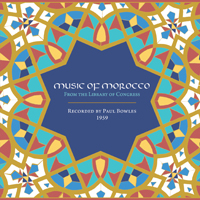
|
MUSIC OF MOROCCO
RECORDED BY PAUL BOWLES 1959 (Dust-to-Digital DTD-46)
Paul Bowles is best known as an American author who lived as an expatriate in Morocco where there would be no scrutiny over his homosexual lifestyle, and that of his wife, Jane (also a fine novelist: see Two Serious Ladies). He was surrounded by others who shared his attitudes, such as British author and painter Brion Gysin, and American William Burroughs, who wrote Naked Lunch while there. "Compared to Tangier," Robert Ruark wrote, "Sodom was a church picnic and Gomorrah a convention of Girl Scouts." Bowles also had Moroccan houseboys, Mohammed Mrabet and Larbi Layachi, who told him folk tales which he tape-recorded and translated into best-selling books. Gysin ran a cafe, the 1001 Nights, and had Gnawa and Joujouka musicians perform there which appealed to Bowles who had been a serious composer earlier in his career. His love of music and ability with a two-track recorder led to sixty hours of 7-inch tape which he made for the Library of Congress in 1959, and which led to their 2xLP field recording set Music of Morocco (1972). That has now been updated into this deluxe 4xCD package. I don't know why Dust-to-Digital felt it necessary to give 4pp of space to Lee Ranaldo to write an "introduction" since he basically says he cannot read Bowles and knows nothing about him. That left a bad taste and did not endear me to the fancy over-the-top booklet bound in fake leather. But it's not all flash and no substance: Philip Schuyler writes a more thorough introduction, mentioning the urgency Bowles felt in 1957, the year after independence, to capture the indigenous music before it was lost to progress, and the impinging influence of Egyptian pop. Bowles bought 78s of local music but it didn't satisfy him so he hit on the idea of making his own recordings. He even sent recordings to Bela Bartok who stole ideas for his "Concerto for Orchestra," as many European composers from Dvorak on down had done to other folk music. On a trip to the USA to deliver incidental music for Tennessee Williams' "Sweet Bird of Youth," Bowles visited the Library of Congress and got training on the Ampex 601 deck. There were two obstacles that stood in the way of the project: the first was electrical power since the Ampex had to be plugged in to 110 volts (American isolationism again!), and the second was official meddling and locals suspicious of whitey with a machine. This meant that often he had to set up a studio in a hotel and persuade musicians to come to him and perform. He also tried to manipulate the artists, telling them the American government wanted certain instruments to play solo and moving others he didn't like out of earshot! You don't need me to repeat the names of the different types of indigenous instruments, flutes, reeds, drums, heard here, but it is a unique and to use the hackneyed word "magical" sound. Once his six-month odyssey was completed Bowles had many hours of music (250 tracks, many over ten minutes long) and urged the Library of Congress to put out 6 albums. His friend Ira Cohen wanted to issue an LP of secular trance music but, again, Bowles wanted too much control over what this would include. There was a certain patronising "Orientalism" -- or racism to put it bluntly -- in Bowles' view of Berber music as barbaric and primitive, but he meant this is a compliment. He was looking for something pure and essential, untainted by outside influences. For this new edition the LC discs have been revised. There are eight additional pieces, and two pieces have been replaced by others of better sonic quality, so this is really an upgrade. And now all the tracks are full length instead of edited for time (forget the notion that repetition gets boring!); as Bowles wrote, "There is no quick way of listening to Berber music." I agree, and it is a delight to steep in this heady mix of musical mint tea and kif-wreathed percussion.
|
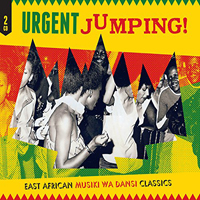
|
URGENT JUMPING:
EAST AFRICAN MUSIKI WA DANSI CLASSICS (Stern's STCD3067-68)
I have been waiting for this release for some time. I held back my review of the Soundway's East African comp so I could write about them together, consequently I have listened to the Soundway comp over a dozen times. On first hearing the Stern's offering one thing is clear: it's much better sequenced, the music flows logically and there's no lurching about from genre to genre with novelties thrown in to derail it. In fact the compiler says he thinks taarab deserves a separate comp and of course that is true. Some of the same groups are included, indeed some of the same tracks. A high point on both of these new compilations is Johnny Bokelo's "Nakupenda sana," which was hiding in plain sight on an LP from Editions Esperance. So, was there industrial espionage on here? "Sina Raha" which was on the first Soundway comp is repeated here. How did both comps end up with this same song, and why does Stern's include it if the compiler started off with 1000 tracks? And why does disc one end with "Dunia ni duara" by Moreno and Moja One since ALL African music fans have the recent Stern's album compiled by Doug Paterson that includes it? And this may be a good time to ask why Doug Paterson did not write the liner notes? The compiler says "Starting in the early 60s, Congolese bands flooded East Africa. Those from Northeast Congo headed for Kampala, from the southern Shaba region to Dar, and all to Nairobi to record." If that sounds familiar, it's the lede on my page on Congolese bands in Kenya: "Those from North-East Congo came to Kampala, Uganda; those from Shaba in the South came to Dar-es-Salaam, Tanzania, but sooner or later they headed to Nairobi for the recording studios there." Despite this unimpeachable source he allows far too many typographical errors to creep in: the title is "Musiki wa dansi" which is wrong. The word he wants is MUZIKI. In Tanzania Muziki wa densi refers to secular music; also he frequently uses the term "zilipendwa" which translates as "they were loved." When referring to those songs which were loved the word is "Zilizopendwa," though "they" can be understood from the context. There are other irritating small errors in here too: Johnny Bokelo's band was Conga Internationale not Congo, Les Maquis were "du" Zaire, not "de." Still, if this seems a bit pedantic (we all call it Muziki wa dansi after all) it is readable, which is more than can said for most CD packages, but then the Soundway sets have fantastic design with lots of band photos, ephemera and labels which are notably lacking here. I eventually made it to disc two and again there is a track repeated from the first Soundway comp (as if it didn't exist): Afro 70's excellent driving "Cha Umheja." Also Sunburst's "Matatizo nyumbani" was recently reissued on Ave Africa: The complete recordings by them. Yes, these five duplications are good cuts but we could have heard some of the other 1000 singles the compiler has that have not been recently reissued. He even holds out a carrot, saying there's a great rare Super Mambo track, maybe implying if we are good there will be a second volume. The "Muziki wa densi" genre refers to Tanzania, but here is one instance where borders are permeable and there's lots of the rumba and benga flavor of Congo and Kenya, as well as the excitement of what sound like live recordings: one take, no multi-tracking. The crystal clarity is another asset of this Stern's set, most of the tracks coming from master tapes in the possession of A.I. Records. The discs should prompt you to start compiling your own set of the thousand best East African tracks.
|
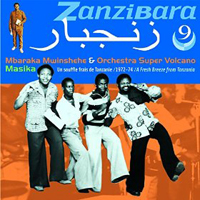
|
MBARAKA MWINSHEHE & ORCHESTRE SUPER VOLCANO
MASIKA: 1972-74 (Zanzibara 9 Buda Musique)
The Super Volcanos are intense, talented, confident. When their leader, Mbaraka Mwinshehe, sings and plays guitar the rest of the band are inspired too: the trumpeter solos, playing jazzy counterpoint to the vocals. Everyone is carried along on the exciting rush. The horns, which add punctuation throughout, lend an excited tone to the production. The spontaneity of a live show is captured in each selection of this fine compilation as Buda Musique continue with their wonderful Zanzibara series, drawing on the musical heritage of Tanzania and the East African coast. The even numbers in the series are Taarab and other traditional music, while the odd numbers are (mostly) the muziki wa dansi that is irresistible. Volume 3 presented the 60s sound, including Jamhuri Jazz, NUTA Jazz, Atomic Jazz and Morogoro Jazz. Volume 5 covered 1978-83, pitting Mlimani Park Orchestra against Dar International, while volume 7 posed Mlimani against I.O.S.S. from the mid-80s. Now we have gone back to the early 70s and one key band, which evolved out of Morogoro Jazz. Drawing heavily from two of the LPs in Polygram's Ukumbusho series (vol 4 and vol 6) we now get to hear Mbaraka Mwinshehe with his band Super Volcano in clarity, with contextual notes, photos and song lyrics added to the restoration. Ukumbusho means "souvenirs" and the remembered good times were spread over a dozen or more albums that appeared in the decade after Mbaraka's tragic early death (aged 34) in 1979 (These included "The Last Recordings" [polp 512] which was followed definitively by "The Very Last Recordings" [polp 517]). Mbaraka's earlier band, Morogoro Jazz, was given its own retrospective on the Dizim label in 2000, with Masimango (Dizim Asili 4702-2). Like "Daktari na mimi (The Doctor and I)" on vol 3, "Morogoro HQs ya Volcano" is a slide guitar tribute to Dr Nico. This was on a Polydor album POLP504 issued in 1974 and tracked down by Doug Paterson; it may have been reissued as vol 12 in the Ukumbusho series, who knows? One track on here, "Posa Na 2" is new to me, but then I am a Mbaraka completist. There is a "Pesa No 1," which is quite different, on a couple of Mbaraka LPs. According to Douglas Paterson it means "Wedding proposal no 2" and is about a brokered marriage where the broker absconded with the dowry. All of Ukumbusho vol 6 is included. Three tracks from volume 4 and one from volume 7 complete this set. Unless you have mint vinyl copies, you probably have not heard these songs with their urgent live-room feeling. There is a raggy sax and trumpet that complement Mbaraka's singing, but his guitar playing is up there with the greats -- Nico & Franco -- to whom he was often compared. The sound is clean, I can hear a clave and guiro in here which were just "surface noise" before on some of the low-fi recordings I have heard.
|
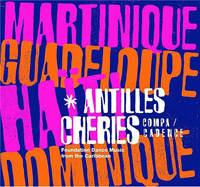
|
ANTILLES CHERIES (Compa/Cadence)
FOUNDATION DANCE MUSIC FROM THE CARIBBEAN (Fanon Records)
An alternative to the "fearless crate-digger" approach to music is for the compiler to be rooted in a regular broadcast, whether on the radio or in a nightclub, where you get immediate feedback and have to stay on top of the music. Thus this new compilation of "the roots of Caribbean dance music" gets straight to the golden discs without a lot of fluff about the Raiders of the Lost Wax. In fact there's one of those Eureka moments at the start: In 1969 the Congolese trio Ryco Jazz had a lengthy stand in the Antilles and brought that flavor back to African music (later evidenced in such great acts as Sam Mangwana & African All-Stars). They had a hit with a track called "Si I bon I di bon" credited to singer Freddy N'Kounkou. This new disc opens with a tune called "Si bon di bon" by Simon Jurad which is the original. This fine compilation of dance music was put together by Emile Omar from his archives of music from Haiti, Martinique, Guadeloupe and la Republica Dominicana. Omar is a DJ at the renowned Radio Nova in Paris who have issued some outstanding tropical comps over the years. They have instituted a label called Fanon Records (after Frantz Fanon, the famous Martiniquan Marxist author of works on the effects of colonialism and a pioneer of "Black consciousness"). Now, there is some very wanky synthesizer that characterizes this right off as late 70s dance-floor fodder, but if you can get past that (it is indeed quaint now), there's an irresistible groove, as on Experience 7's "Banzai." 1979 was in fact the turning point in the music as the little huts where these bands played biguine were wiped off the earth by the 175mph Hurricane David; when the music gradually came back it had evolved into zouk. Despite this being primarily dance music, inevitably if you cannot follow the creole you will miss the humor in the lyrics which have sexual double entendres (the coconut refers to a favorite part of female anatomy) and veiled political commentary. There is an outstanding 15 minute cut from Rodrigue Millien, who also features on the new Tanbou Toujou Lou comp. The late great Coupé Cloué appears with his classic "Plein caille" which he recorded as Henry Gesner and Trio Select at the start of his career. This is a fine entry in the "Peanut vendor" playlist, though my pal Ken Abrams says it's a cover of "Sawale" by Rex Lawson. These chéries deliver the Antillean groove in fine style.
|
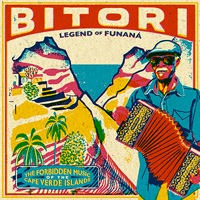
|
BITORI
LEGEND OF FUNANA (Analog Africa AACD/or/AALP 081)
For small remote islands off the West coast of Africa at the latitude of Senegal, Cabo Verde packs a musical punch far above its fighting weight. Successive currents of great music have come from there over the years. We know of "morna," the bittersweet bluesy form, because it was promoted internationally through the success of Cesária Evora. The line-up invariably included the tiny mandolin-like cavaquinho (which is also popular in Brasil), clarinet, accordion, violin, and sometimes, piano and guitar. "Coladeira" is another indigenous rhythm, more uptempo, which incorporates elements of samba and zouk, as waves of popular music arrive in the islands and are absorbed. The main noticeable difference is the guitar part which uses a thumbed bass note, followed by a chorded strum with the other fingers in a two-part boom-ching beat. These forms were brought to us by Popular African Music on two CDs: Music from São Nicolau (pamap 603) and Conjunto Mané Pchei (pamap 604), recorded in 1980 before synthesizers and electric guitars took over. A third, more engaging form -- Funaná -- came to our attention with the Ferro Gaita album on Harmonia, as well as the Palop Africa! anthology on Earthworks in 1999. The story of this newly reissued album began in the early fifties with a young man, Victor Tavares, known as Bitori, determined to get his hands on an accordeon. And where does someone from a small island in the Atlantic go on such a quest? To another island, this one being the other Portuguese colony of São Tomé, further south. After he mastered the instrument, Bitori launched into the folk music scene playing funaná accompanied by the sound of an iron rod scraped by a kitchen knife. The raw roots music was banned by the authorities and remained underground until independence in 1975. Tavares was approached by a singer, Chandal Graciosa, who suggested if they went to the Netherlands they could record an album. And so the legendary Bitori album first appeared in Holland and immediately swept the duo to fame at home. By then Bitori was 60 years old. Now intrepid musical explorer Samy Ben Redjeb has found the original artists and their album and brought them back to us. To the ferro and gaïta (iron rod and accordeon) they added bass and drums. There's also whistling on one track. It's rocking folk music, not too dissimilar from batchata or zouk, but with a great propulsive urgency to it.
|
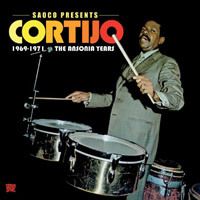 | CORTIJO
THE ANSONIA YEARS 1969-71 (VampiSoul 166)
Roots, mon. What kinda roots? Bomba y plena: two of the roots of salsa. Rafael Cortijo y Su Combo took Puerto Rico by storm with their tropical dance music before the principals moved to the Big Apple. (Those who remained reformed as El Gran Combo.) Cortijo lived in the Bronx and was part of the immense wave of Latin music that transformed the cultural capital of the USA as Puerto Rican elements merged with Cuban, Colombian and other styles to create salsa. But Rafael fondly remembered Sunday in the park from his boyhood in San Juan, Puerto Rico, with groups of drummers jamming. So in 1970 he decided he wanted to record a stripped-down sound with fewer instruments, to focus on the drum and vocals and indeed push the drumming to the fore, instead of letting it be buried in the mix, and recreate this remembered sound. There's still a nice piano montuno part (Javier Vázquez, ex-Sonora Matancera) low in the mix, and the odd horn comes in, but the coro is riding on some Afro-Cuban percussion -- conga played by Cortijo, timbales, bongo, cowbell, guiro -- that is loud and clear. Cortijo's partner in this project was fellow percussionist, timbalero Kako (Francisco Bastar), along with two leading Puerto Rican singers, Ismael Rivera and "Chivirico" Davila. Ansonia released three albums of this style: Ritmos y Cantos Callejeros (Rhythms and Sounds of the Street), Noche de Temporal (Stormy Night), and Volume 2, between 1969 and 1971 and the best of them is presented here in 16 3-minute tracks. Interestingly the last track brings the full band in, the piano is up in the mix with bass, trumpets, sax and trombones, and it is really fine.
|
















